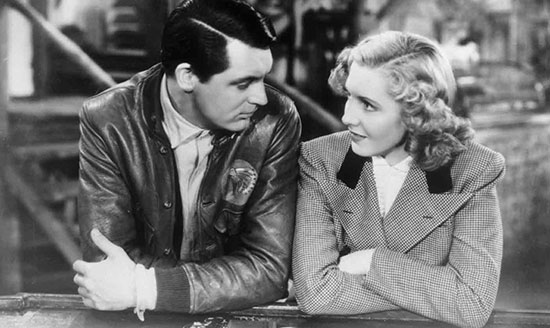Classic Hollywood: Jean Arthur

“Never have I seen a performer plagued with such a chronic case of stage jitters. I’m sure she vomited before and after every scene. When the cameras stopped, she’d run headlong to her dressing room, lock herself in and cry. Those weren’t butterflies in her stomach. They were wasps.”
So wrote director Frank Capra of Jean Arthur, the woman he called “my favorite actress.” I discovered Jean in my teens while reading Capra’s autobiography, The Name Above the Title. Who was this appealing, neurotic star, so publicity-shy that she was dubbed the “American Garbo” by Movie Classic magazine in 1937?
Jean was born Gladys Georgianna Greene on October 17, 1900 in Plattsburgh, New York, to a family that included three older brothers and parents who apparently liked the letter “G.” Starting with a bit part in John Ford’s Cameo Kirby (1923), Jean toiled in silent films for seven years using a screen name that honored her personal heroes, Jeanne D’Arc (Joan of Arc) and King Arthur.
In 1935, Jean’s most distinctive asset caught Capra’s attention: “That voice! Low, husky – at times, it broke pleasingly into the higher octaves like a thousand tinkling bells,” he recalled. By then, Jean had made more than 70 pictures, yet for some reason, stardom eluded her. Capra’s boss Harry Cohn had a theory: “Great voice. But did’ja see her face? Half of it’s angel and the other half horse.” Capra agreed: “Her ‘bad’ side made her look like a different person. Sets had to be constructed [that] showed only her ‘good’ side to the camera.”
Jean finally busted out of career purgatory in a trio of Capra hits: Mr. Deeds Goes to Town, You Can’t Take It With You, and Mr. Smith Goes to Washington. Co-star James Stewart called her “The finest actress I ever worked with. No one had her humor, her timing.” By 1939, Jean’s talents were in such high demand, she was even a finalist to play Scarlett O’Hara in Gone With the Wind, despite the fact that she was pushing 40.
Ultimately, the stage fright that Capra noted curtailed Jean’s career. She ditched the Broadway tryout of Born Yesterday in Boston, and her 1950 production of Peter Pan ran less than a year. After shooting Shane in 1953, Jean made two TV appearances in the ‘60s, then taught drama at Vassar, where she praised a student named Meryl Streep (“It was like watching a movie star.”)
(Gotta love this anecdote by a Vassar colleague: “Jean was very down to earth and hated people putting on airs. We were at a reception after a play and a woman who obviously thought herself to be terribly important came up and introduced herself to Jean. Quick as a flash, Jean said, ‘And I’m Martha Washington!’ to which the woman had no response. It was almost like a Marx Brothers scene.”)
Speaking of classic moments, screen these Jean scenes: Reading Gary Cooper’s poetic proposal in Mr. Deeds (fast-forward to the 1 hr. 5 min. mark); her virtuoso portrayal of a tipsy Senate aide from Mr. Smith (at 1:09 of this clip); and Joel McCrea’s “handsy” seduction that makes Jean’s knees buckle in The More the Merrier (1 hr. 11 mins. in).
Classic Hollywood posts appear bi-monthly on The Music Hall blog.
